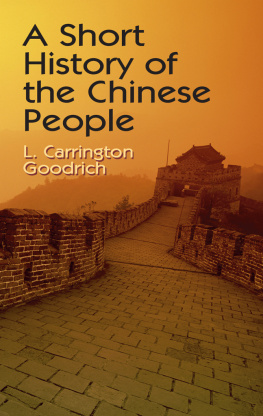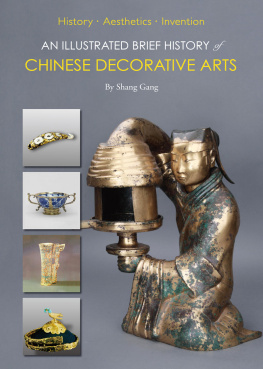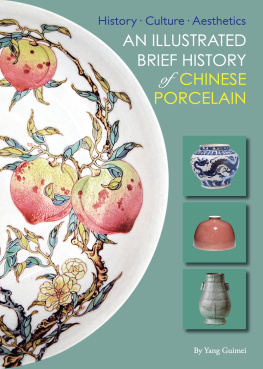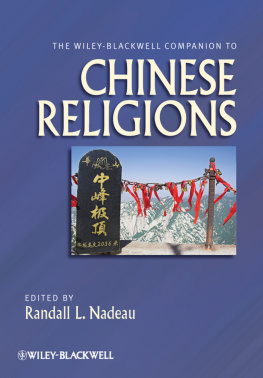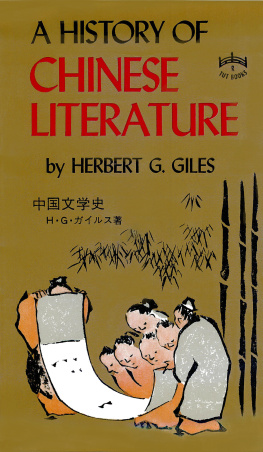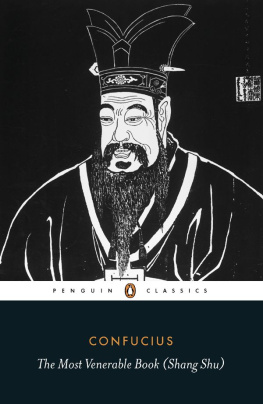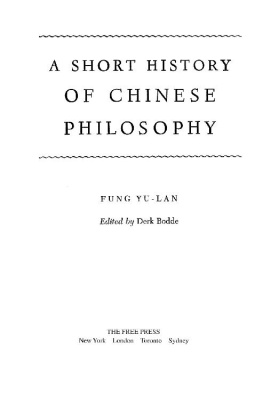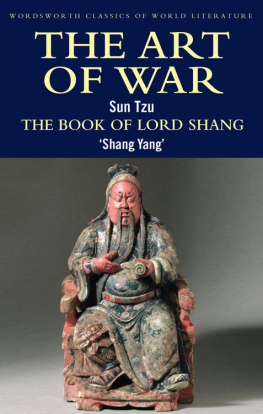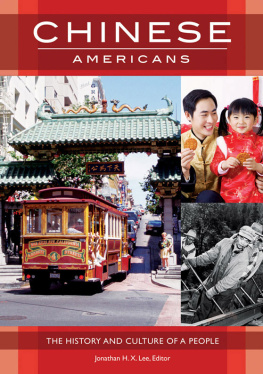A Short History of the
CHINESE PEOPLE
L. CARRINGTON GOODRICH
I LLUSTRATED
DOVER PUBLICATIONS, INC.
Mineola, New York
Dedication
to ROBERT K. REISCHAUER
First American casualty in the Second World War,
who urged the writing of this book
Copyright
Copyright 1943, 1951 by Harper & Row, Publishers, Inc.
Copyright 1959, 1969 by L. Carrington Goodrich
All rights reserved under Pan American and International Copyright Conventions.
Published in the United Kingdom by David & Charles, Brunel House, Forde Close, Newton Abbot, Devon TQ12 4PU.
Bibliographical Note
This Dover edition, first published in 2002, is an unabridged republication of the 1969 Fourth Edition of the work originally published in 1943 by Harper & Brothers, New York.
Library of Congress Cataloging-in-Publication Data
Goodrich, L. Carrington (Luther Carrington), 1894
A short history of the chinese people / L. Carrington Goodrich.
p. cm.
Originally published: N.Y.: Harper & Bros., 1969.
Includes bibliographical references and index.
eISBN 13: 978-0-486-16923-1
1. ChinaHistory. I. Title.
DS735 .G58 2002
951dc21
2002071601
Manufactured in the United States of America
Dover Publications, Inc., 31 East 2nd Street, Mineola, N.Y. 11501
Contents

Illustrations

I LLUSTRATIONS W ILL B E F OUND F OLLOWING P AGE 140
PLATE
Maps

Preface to the First Edition

T HE history of the Chinese people cannot often enough be told. Old as it is, new light is being shed on it every year. Meanwhile the Chinese are making history before our eyes. We need, as never before, to understand how they have come in our time to make such a sacrificial defense of a way of life that is theirs as much as it is our own.
The Chinese are different from us; at the same time they are more like us than the people of India, of Annam, or of Japan. At the conclusion of the last war, the writer served for a time with a Chinese labor battalion attached to United States forces in France. Again and again, puzzled American corporals and sergeants helping to direct the battalion remarked to him on the innate likenesses between themselves and the Chinese, despite the barrier of language and difference of custom. They wanted this phenomenon explained; so have others. It is worth while therefore to examine the record, and see how the Chinese people have traveled down the corridors of time from the Old Stone Age to the present.
Another good reason for a study of Chinese history is to make it serve as a foil for our own. Semi-detached from some of the other great civilizations of the world, the Chinese have yet evolved in some ways like ourselves, in some ways not. They have a great historical tradition. So had the Romans; but the Hindus have not. Why? The Chinese learned a great deal about the stars, devised a workable calendar, and made several praiseworthy achievements in mathematics, medicine, engineering, architecture, geography, and historical criticism, but did not arrive at a fully rounded scientific method. Again why? There are many such questions that one can pose. Not all the answers are in this book. It is the writers hope, however, that the reader will have a fuller understanding of the background and a greater ability to get at the answers after he has concluded the last chapter than when he started. Naturally some of the questions can meet only with speculative replies, and these can never give general satisfaction. It seems to the writer, none the less, that a thorough study of Chinese civilization will give every student of history, whether of the peoples of Europe, of western Asia, of the Americas, or of any other region, a better basis for comprehension of that history. Indeed, this is the only way to reach a global understanding.
A final reason is to profit from the empirical knowledge of the Chinese in many fields. To give two examples: It is said of Vice-President Wallace that he has inwardly digested the monographic material on the policies of the eleventh-century statesman Wang An-shih, together with their application and fruit. Another case is that of the United States Department of Agriculture which for years has been actively studying and endeavoring to exploit Chinese experience in afforestation, production of certain crops, soil enrichment, prevention of plant disease, and the like. Similar examples might be cited. They certainly should be increased.
The summary treatment of any subject of so vast a scope as the one under hand is bound to be uneven. Every general history of China yet undertaken suffers from that fault, and the writer is conscious that his is no exception. He hopes, however, that the suggestions made under the heading of Supplementary Readings will afford some remedy. One thing which he has consciously done needs explanation. The chapter on political disunion (is long. The reason for this is threefold: first, a discus-tion of so confused a period can hardly be abbreviated without making it nearly meaningless; second, Buddhism and Taoismparticularly the formercame into their own then and vitally affected all areas of Chinese life j and third, this period is the trunk from which much of the culture of Korea and Japan and other contiguous areas sprang; to know them one must have more than a cursory knowledge of the four centuries beginning about A.D. 200.
It remains to acknowledge with gratitude the help the writer has received from many sources: from his students for much they have taught him; from his colleagues for their friendly criticism and aid; from Miss Dorothy Thompson of Harper & Brothers for editorial assistance on the book; from Mr. Henry C. Fenn, for permission to make adaptations of one of his charts; from several people and institutions for permission to use their photographs for illustration; from the writers of many books and papers whose translations he has used and acknowledged in the text; and from many Chinese friends of every age and station. The resulting work is unworthy of their aid, but it goes out with a prayer for indulgence from them all.
L. C ARRINGTON G OODRICH
It now appaears that Mr. Wallace was primarily interested not in Wang An-shih but in Wang mang (d. 23 A.D. ). See his letter to Derk Bodde, Quoted in the Far East-ern Quarterly V 412 (August 1946).
Preface to the Third Edition

S INCE this book was first published (in 1941) the Chinese, perhaps more than other people, have been subjected to remarkable pressures, which have resulted in profound changes in every field of their life, political, military, social, and cultural. This edition, like the second, takes account of these changes. Advantage is also taken of the opportunity to make a few revisions in the text in the light of recent scholarship.

